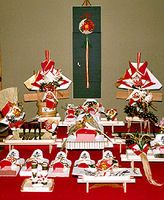

Total:131items
- Pottery & Porcelain (18)
- Lacquerware (4)
- Glasswork (2)
- Wood & Bamboo Work (19)
- Leather Work (1)
- Papermaking (13)
- Textile (20)
- Dyeing products (5)
- Masonry (1)
- Metal Work (11)
- Stationery (4)
- Livingware (3)
- Accessory (4)
- Toys & Entertainment (14)
- Hyuga Goishi: Huga Go Stones
- Kurashiki Hariko: Kurashiki Papier-mache
- Kishu Bina : Kishu Dolls
- Hakata Ningyo: Hakata Doll
- Kaga-mizuhiki: Kaga Paper Cord Ornament
- Kasukabe Oshie Hagoita: Kasukabe's battledore with a padded cloth picture
- Iwatsuki Ningyo: Iwatsuki Doll
- Tsugaru Tako: Tsugaru Kite
- Jindai-Goma: Jindai Spinning Top
- Suruga Hina Dolls
- Knohazaru: Konohazaru Dolls
- Mishima Oni Yōzu kite (Mishima Demon Kite)
- Gunma Kokeshi Doll
- Koga Ningyo: Koga Clay Doll
- Interior (2)
- Other crafts (10)

 |
Main Production Site:Ishikawa |
 《Characteristics》
《Characteristics》Mizuhiki is a bundle of decorative twisted paper cords which has been used by way of ornament in exchanging betrothal gifts. A butterfly made of Japanese paper to decorate spiced sake (the Japanese drink this sake to celebrate New Year's) gave Mr. Soukichi Tsuda、the initiator of Kaga-mizuhiki, a significant hint. And he designed emperor and empress dolls in the early days of the Taishou Era (20c). His dolls established the foundation of later Mizuhiki dolls.
Soukichi worked out colors and designs to create works of art on his own aesthetics. . Dolls made by him are creative Mizuhiki dolls, which are representative of arts and crafts in Kanazawa, the old castletown of Ishikawa Pref., Central Japan. The spirit of wabi and sabi (aesthetic sense in Japanese art emphasizing quiet simplicity and subdued refinement) that is found in the climate of Kaga (the former name of Ishikawa Pref.) is embodied in his dolls. His dolls even create an atmosphere of dignity and are thought highly of.
Government-designated traditional craftwork
(designated by the Economy, Trade and Industry Minister)
Provided by: Digital Archives of Ishikawa Japan
Pictures provided by: Tsuda Mizuhiki Origata
Translation by: Yoshinori Sakamoto

| Materials | Japanese Paper |
|---|---|
| Crafting Processes | [1] Japanese paper part
Dyeing | Folding | Make three-dimensional decorations by folding Japanese paper [2] Mizuhiki part How to make mizuhiki: First twist Japanese paper cut long and narrow into strings. Next spread seaweed and white clay or paste on them to harden. Finally rub them with cotton to polish. Before using them, dye them. | Color matching | Partial twisting: Twist mizuhiki into decorations. [3] Put Japanese paper[1] and mizuhiki[2] together Determine the overall shape in advance and put parts together. Adjust the shape minutely. | Completion |
| History | When the Japanese give a person a present, he/she wraps the present in paper, puts traditional paper for wrapping a gift called noshi on it, and tie them with mizuhiki. This is a long-established custom in Japan which represents thanks and respect.
In the early days of the Tokugawa shogunate (17-19c), the culture of offering tributes to feudal lords from samurai families developed and consequently decorations made of beautiful mizuhiki were worked out. Such a culture has been handed down as a tradition until today. You might say mizuhiki is the representation of the Japanese feeling of thankfulness, which has been shaped up as ornament. A long time ago, in order to make string and cord, people in those days made hemp soft by soaking it in water ("mizu" in Japanese) and then skinned it. It is said that the term of "mizuhiki (literally, pulling water)" results from this process. Mizuhiki was used as "a paper cord for tying the hair" in the Edo period (17-19c). It seems that some samurais made it as a side job in Kanazawa. Men and women seldom did their hair up in the traditional Japanese style since the Meiji Restoration. That's why mizuhiki is rarely used as a paper cord for tying the hair in the present day. However, the needs for decorative mizuhiki for special presents do not completely disappear. Such mizuhiki has recently become more splendid and magnificent than before. |
◆Exhibition / Showcase
Ishikawa Prefectural Museum of Traditional Arts and Crafts
1-1, Kenroku-cho, Kanazawa
Tel: +81-076-262-2020
Fax: +81-076-262-8690
(Japanese only)
Assistance needed? For inquiries in English:
JTCO Contact Form
Your inquiries will be forwarded by JTCO in Japanese to the organization you wish to contact.



